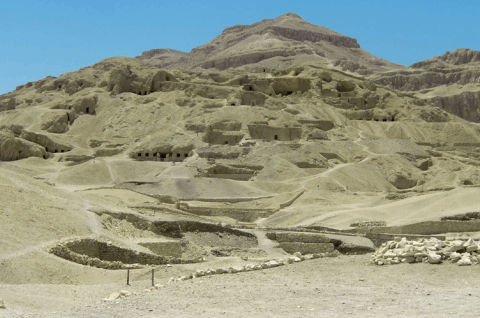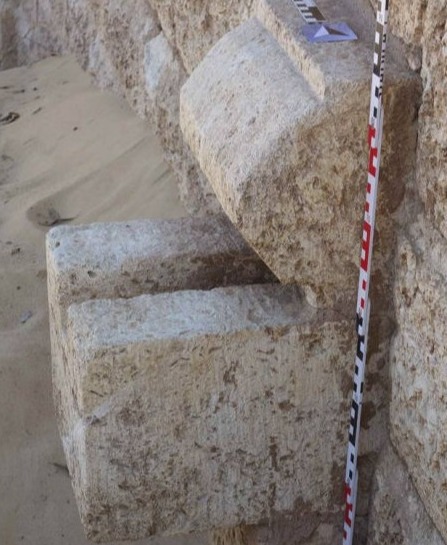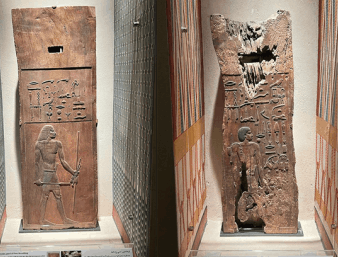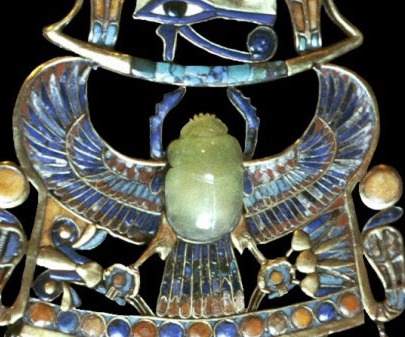




The Life and Times of Hesyre, the First Recorded Physician and Dental Surgeon in History
Dr Roger Forshaw







January 2025

Dr. Backhouse began by explaining that she was going to be looking at what we actually know about Nefertari and Ramesside Queenship. A very interesting topic, given that we feel we know a great deal about 18th Dynasty queens, but it is not in fact until the 19th Dynasty that we have queens being buried in the Valley of the Queens, which makes them so much more visible.
We know that Ramesses II’s most notable wife, his Great Royal Wife, was Nefertari and that together with Isetnofret they are the mothers of his favourite children. Images of the children of both are depicted concurrently, though we never see both Nefertari and Isetnofret in the same scene.
It is likely that Ramesses II married Nefertari whilst he was still the Crown Prince, but we know nothing of her life beforehand other than that she came from a family which moved in the elite circles at court. We see her from year 1 of her husband’s reign taking part in cultic activity and from the start of his kingship she is involved in both political and religious roles, being his constant companion. She accompanies him on many of his statues, although as many of these are usurped, and often from Amenhotep III’s reign, the lady depicted originally was Tiye.
Her titles give clues to her diverse roles – political, religious and personal. As the political Nefertari she is Mistress of the Two Lands, wife of the Strong Bull, Lady of Upper and Lowe Egypt, whereas God’s Wife is descriptive of her religious obligations. In personal terms she is described as hereditary noblewoman, sweet of love, great of praises, lady of charm and great royal wife his beloved.
There are many carved examples in temples of Nefertari carrying out cult activities, but she is the only Ramesside queen who is shown at a Window of Appearance taking part in the ceremonies with the king. She is also recognised on the international stage, with letters found showing exchanges with the Hittite queen.
One of the greatest dedications to Nefertari is of course at Abu Simbel. On his own temple there Ramesses II has various female members of his family represented by his ankles, but the prominent position is reserved for Nefertari. But the smaller temple is actually dedicated for her and two of the statues fronting the temple are of Nefertari. It is extremely unusual to see a queen on the front of a temple, however Ramesses II also include four statues of himself! There are more highly unusual scenes inside the Abu Simbel temples with Nefertari attending at a smiting scene, although she does not take part herself (as Nefertiti did). In the inner sanctum of the smaller temple there is a unique and remarkable scene which appears to show Nefertari being crowned by Isis and Nephthys, which parallels a similar scene in the larger temple with the same act taking place for Ramesses II between Seth and the local form of Horus. Another scene shows the king and queen worshipping one of the gods together; an ultimately powerful image. On the Stela of Heqanakht there the lower register shown a seated Nefertari receiving devotions, whilst Rameses II, offering to the gods on the upper register, is followed by one of his daughters. Could this be an indication of some frailty on Nefertari’s part? She disappears from the record between regnal years 24 and 30.
Nefertari has an exquisite tomb in the Valley of the Queens, the Place of Beauty, which had previously been used for burials, but not for that of queens. It was rediscovered in 1904 by Schiaparelli but had been disturbed long before this. Prior to the 19th Dynasty New Kingdom queens had been buried either in an undecorated chamber in the king’s tomb or in an undecorated tomb of their own in the Valley of the Kings. Nefertari’s is the largest and most sumptuously decorated of the tombs in the valley, with a complex architectural design, and the extensive and beautiful decoration tells the story of her transformation as well as ensuring that she has a successful afterlife. Images of Nefertari show her with darker skin tones than usually used for females, which may refer to her need to become an Osiris – the road to rebirth for all at this time period. Her skin is also shown shaded, rather than straight block colour, which was the norm, again perhaps relating to rebirth. At one point Thoth is depicted conferring scribal proficiency on Nefertari, who will need this skill to read and recite the names of the Announcer, Guardian and Gatekeeper as she passes through the series of gates leading to the Duat.
Dr Backhouse concluded the lecture underlining that this was a fascinating period for Queenship in Ancient Egypt’s history with very visible markers on the landscape and a significant shift in the archaeology with the new treatment of tombs for the queens.
Febuary 2025

In her recent research Dr. Finch has been looking at Ancient Egyptian medical remains alongside other pathologists and dentists also looking at similar matters. She found that examining Ancient Egyptian medical papyri and other sources generated tremendous insight into how the Ancient Egyptians treated illnesses.
Clement of Alexandria (2nd Century AD) wrote six books of medical interest mainly on the diseases of women. At Kom Ombo reliefs on the walls show medical instruments. Many medical papyri give glimpses of medical procedures and practices alongside details of anatomy, diseases, diagnosis and remedies including herbal ones, surgery and magical incantations.
The Edwin Smith papyrus, produced around 1500BC, is of great importance in this regard and can now be found in the New York Academy of Medicine. It was found near Thebes and sold in 1862 to Smith. It has 17 pages but is not complete. It lists a variety of ailments and treatments, but also includes ailments not to treated. 48 conditions are looked at starting from the head and stopping at the waist, so it is clear from this that it is incomplete. Number 4 says not to bind the head, number 6 says just use ointment without binding and no use of plaster, number 7 (relating to a fracture) says bind on fresh meat, apply a honey ointment and stay sitting. Number 33 describes how to treat a crushed vertebra in the neck and asks is the patient unconscious or speechless(?), can he move his arms or legs? - then decides no treatment should be applied as he will not recover.
The Ebers Papyrus, also found in Thebes and in 1872 sold to Georg Ebers, is made up of 110 pages. Written in about 1534BC in the 9th year of the reign of Amenhotep I it looks at gynaecology, obstetrics, purging and worms. Similar are the Hearst Papyrus and the Kahun Medical Papyrus, which covers gynaecology, pregnancy and paediatrics. One recommends using suppositories or pessaries made of honey and crocodile dung as a contraceptive. The Ramesseum Papyrus looks at diseases of children and women and at conduits moving fluid round the body. The London Papyrus, found in 1860, contains 25 paragraphs of medical information and the Berlin/Brugsch Papyrus has 24 pages on breast disorders, pregnancy, children’s illnesses and birth control. Similarly the Carlsberg VIII Papyrus considers diagnosing pregnancy and ensuring a child’s gender.
More practical medicine is found in the Brooklyn Papyrus which looks at snake, spider and scorpion bites and stings and is believed to be a 30th dynasty copy of a Middle Kingdom 13th Dynasty medical treatise. The Papyrus Oxyrhynchus contains parts of the Hippocratic Oath.
The Chester Beatty VI is described as a ’rather special’ papyrus. It is from the 19th Dynasty and was purchased by Alfred Chester Beatty, a prospector, mining magnate and philanthropist, who gifted it to the British Museum. It looks at diseases of the anus and their treatment. There are 41 prescriptions, many similar to those in the Ebers Papyrus. Conditions considered are prolapse of the anus, expelling worms, reducing swelling, pain, bruising, flatulence and blood loss. Suggested treatments are using honey, juniper and wormwood as an ointment, using flour, bryony root, senna and dates as a laxative, antimony for bleeding and many others. Sometimes instructions are given to pound these together to make suppositories, pessaries or pills to swallow. The fluid in the conduits can carry these medicines, or the illnesses, around the body. A cure for round worms or tape worms was to mix pomegranate juice with other laxatives, leave it to stand overnight then drink.
So, what do we learn from these early studies? It is evident that early Egyptian practitioners had knowledge of anatomy, observation and diagnostics, physiology, treatment and prognosis, prescriptions and the use of magic. In a tomb at Deir-el Medina inscriptions show incidents of the treatment of trauma; for instance using splints on a broken leg. Dr. Finch showed diagrams from an Australian PhD study showing an examination of which parts of the body were recognised by Ancient Egyptians. She then looked at the idea of conduits connecting all parts of the body, as seen in the Ebers Papyrus, which describes them as six leading to arms, two each to the testicles, nose, ears, buttocks, lungs, forehead and eyes, plus four each to the liver and rectum. All of these ancient doctors described the connections as going via the heart, anus or rectum. When it came to measuring medicines they used volume based on the eye of Horus, representing unity, with cups showing measures on the side. It is clear that there were different doctors who specialised in different parts of the body.
Herodotus describes there being a Shepherd of the Anus as an example. And it is interesting to note that many of the herbal remedies are still being used today such as senna pods as a laxative, and then, as now, gut health was taken very seriously.
March 2025

Dr. Slinger shared with the Society details of her interesting and extensive PhD research into the placement and distribution of New Kingdom tombs in the necropoli in Thebes.
She looked at the sacred landscapes along the processional routes, especially that of the Beautiful Festival of the Valley, which followed a route from Karnak across the Nile to the West Bank. During the festival people would go to their family tombs and enjoy banquets with both the living and the dead. The tombs of nobles surrounded and lined the route and were placed as close as possible to the royal tombs between the disembarkation point from Karnak and Deir el-Bahri. Over time these tombs spread into the surrounding areas; Dra Abu el-Naga, Qurnet Murai, Shiekh Qurna, el Asasif and el Khokha.
Dr. Slinger’s research covered 5 main areas :
1. How did the Theban necropolis evolve over time?
2. Were there individual family tombs?
3. Is there evidence of occupational clusters of tombs, for example priests or scribes?
4. Were individuals buried around supervisors; officials around their Viziers?
5. Did being in sight of mortuary temples or the route of the festivals influence where tombs were built?
She firstly created a data base of burials and their placings using GPS to pinpoint their exact locations. This helped in linking the titles of tomb holders together to check for evidence of associations. Prior to Hatshepsut only a few 18th Dynasty tombs were found near the tomb of Montuhotep so evidence is scarce, whereas by the end of the reign of Thutmosis III more information is available due to the proximity of the mortuary temples found there, with some tombs showing evidence of being reused. A cluster of tombs from the end of the 18th Dynasty have been found in the central area, which became popular along the route of the processional way.
During the reign of Ramesses II there was a resurgence of burials here even though many chose to be buried at Saqqara. However none were buried near Hatshepsut’s temple or near the Ramesseum.
She also looked at tomb reuse, finding that many Middle Kingdom and Ramesside tombs were reused, some by family members but also some by unconnected strangers, probably due to a lack of resources.
Many occupational groups were buried in clusters: priests, temple administrators, royal administrators, general and state administrators, local administrators and those with a military title. Dr. Slinger was able to research this, using GPS, to establish that there was a hierarchy to these tombs based on status, with the most important persons having their tombs in the highest spot with the best view of the processional route, especially in Qurna. This might suggest royal or priestly input into who was buried where.
She looked at a series of case studies, the first being the tombs of Viziers, suggesting that the site of their tombs was given to them as a result of their importance; for example tombs TT83 (Amethu called Ahmose) and TT61 (Useramen). Both have a commanding view and suggested that like was buried near like. Another tomb belonged to a Vizier who inherited his position from his father and was entombed near to him. This suggests that tomb sites were chosen by/ granted to a family or workgroup - for example tomb TT100 (Rekhmire). If the Vizier fell from grace, his replacement and his family might take over his original tomb site.
The area known as the Amenhotep II Quarter was linked to him as the burial site of his childhood friend Pairy; another family group buried near to each other with a clear line of sight to his mortuary temple and the processional route. 18th Dynasty Viziers would seem to have had considerable power over who was allocated which tomb site.
When the High Priests of Amun became more powerful tomb scenes became more religious in content and fewer scenes of daily life were shown. Additionally they began to build the tombs closer to Dier el-Bahri, opposite Karnak, as the Pharaoh’s power was decreasing and theirs was growing. Significantly two High Priests converted older structures into mortuary (cult) chapels, demonstrating further how their power had increased.
At Dra Abu el-Naga a separate cluster from the Ramesside period was created with a good view of the processional way from Karnak. There are 17 tombs, 3 of which belonged to High Priests, together with a family group, which shows that the High Priests of Amun could also control who was given burial sites and where. Karnak was visible from Deir el-Bahri and from Dra Abu el-Naga, so these were sought after sites.
So how did these sites evolve? It seems to have been a gradual process where some were used extensively over a long period and some for only a short time. They were influenced by status, desirability of location, spatial connections, resources and available space. During the 18th Dynasty and the Ramesside period links amongst families were important as many positions (Viziers, High Priests, officials) were inherited and so the generations were entombed near each other. Viziers’ tombs acted as focal points, as others wanted to be entombed near illustrious predecessors. That and a view of and orientation towards a mortuary temple or the processional route was an important reason for selecting the site where you would rest for eternity.
June 2025

Colin began his lecture by reassuring us that, despite the title of his lecture, aliens would not be featuring! The extraterrestrial aspect is, in fact, connected to the large yellowy green coloured scarab at the centre of one of the pectorals found in Tutankhamun’s tomb.
Until fairly recently it was thought that the stone was chalcedony, which is not particularly special, begging the question of why it was used for the centre piece. However, analysis by Vincenzo de Michelle has revealed that it is actually silica glass and a very specific type of silica glass; Libyan Desert Glass, which is highly unusual and scarce. Did the court of Tutankhamun use this particular stone because they knew just how rare it was? The only source of this is a very localised area way out in the Western Desert – north of the Gilf Kebir and south of the Great Sand Sea – about as far from Thebes as possible and away across extremely forbidding terrain. It was rediscovered in 1931 by Pat Clayton during his exploration of the desert.
The pale yellow/green substance is translucent and entirely natural. It was thought to have been created by the huge energy resulting from the impact of a meteorite (the extraterrestrial connection). There are numerous examples of such impacts around the globe and indeed close to this area, in Libya and Sudan, including one which produced Dakhla Glass, which is somewhat darker than Libyan Desert Glass. The resultant craters are usually very large and the rock and soil typically melt at 1000C. As the molten material is thrown out of the crater and cools down, glass is created.
But one of the mysterious features of the Libyan Desert Glass site is that there is no crater. The chemical composition of the glass is also highly unusual with more than 95% silica. It might be thought that, as the area is composed of Nubian Sandstone, a high silica content would be expected. But this is, of course, today’s geology. The glass is thought to have been made about 26 million years ago when the geology was considerably different; at that time the terrain was lush green forest covering limestone. Another site across the world provides some clues. In 1908 there was a massive explosion in Siberia at Tunguska – fortunately this happened in an extremely remote location, so there were minimal casualties. For more than a thousand square miles the trees had been laid flat, in a circular pattern. Initially a meteorite strike was assumed to be the cause, but again there was no crater. The alternative explanation given was of a comet entering through the atmosphere and exploding just above the surface. In the Western Desert not far from the Libyan Desert Glass site another extraterrestrial material, hypatia, has also been found. This stone is not part of the composition of meteorites, but is typical of comet material. An exploding comet seems to fit the lack of crater and strange composition of the glass. When the glass finally made its way to Tutankhamun’s artisans they knew it was highly unusual, but can have had no idea of its extraterrestrial origins.
Although it was a huge distance from the glass site to Thebes, the Ancient Egyptians were well aware of the rich mineral resources in the deserts and, from very early on, mounted expeditions to explore and exploit the minerals. In the Western Desert the oases were stopping off points between the Gilf Kebir area and Thebes and Desert Road Archaeology, a relativity recent field of study, has revealed a comprehensive network of ancient caravan routes criss-crossing the desert between the Nile Valley and the oases, then westward to Gilf Kebir and Uweinat and yet further west and south towards Sudan, Chad and Kufra. The Libyan Desert Glass site lies within these caravan routes and this trading network may have allowed the glass to travel to Thebes. Evidence of 18th Dynasty travel across the desert can be found in deposited water jars at way points such as Abu Ballas and Djedefre’s Water Mountain (though the majority of the artefacts at the latter deposit date to the Old Kingdom and First Intermediate Period).
Major Ralph Bagnold, in the 1930s, undertook many exploratory trips far out into the Western Desert, testing how well the early motor cars could cope with the terrain compared to camels and published his results, together with highly accurate maps of the area. With each expedition the amount of detail on the maps increased to finally include springs, temporary pools, previous expeditions, ground conditions, topography and sites of rock art. The ‘cave of the swimmers’ at Wadi Sura on the west side of the Gif Kebir came to light again with its intriguing images and, more recently, the Mestakawi cave with its huge numbers of paintings of animals, people and hand prints. It is clear that there are layers with newer painting overlaying older images and the people depicted are various shapes, sizes and colours, which makes us wonder if this area was a trading location even back then with different people and cultures meeting up. What do we know of these ancient people? The climate has changed considerably over the ages varying from very wet to much more arid. There is evidence in the form of hand axes and other tools of people up to 300,000 years ago. Some are of extinct species predating homo sapiens and a recent Oxford expedition even found a hand axe made of Libyan Desert Glass. By 7000 BC the vegetation in the area had shrunk back so that there was very little greenery other than in the oases, the Gilf Kebir, Uweinat and the Nile Valley. Scholars have divided the rock art into six age groups from A-F, although it is very difficult to pinpoint specific dates. The Wadi Sura rock art is thought to belong to group E from around 5500 to 4500 BC. About 4500 BC the climate changed to seasonal monsoons and cattle pastoralists made their living in the desert. The arid state that we know today began at around 3500 BC.
Understanding the imagery in the rock art panels is problematic. There are some large enigmatic headless beasts, upside down people and some completely unidentifiable creatures. Scholars studying this material have wondered if they can see parallels with later religious imagery and have questioned if we are seeing the start of theological ideas. Not everyone agrees and the debate continues.
In 2022 Colin’s book ‘A Gift of Geology’ was published by AUC Press. He is now working on a second book with the working title ‘The Great Sphinx: re-writing the history of the world’s most iconic monument’, which he is hoping to have published in the near future.